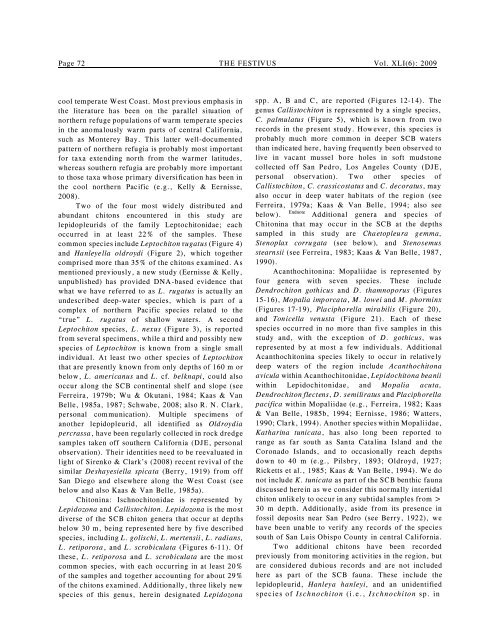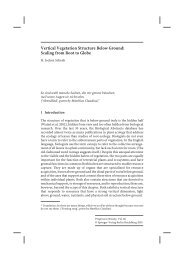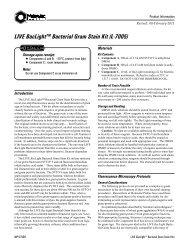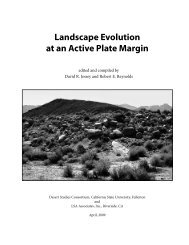Chitons (Mollusca: Polyplacophora) - Biological Science - California ...
Chitons (Mollusca: Polyplacophora) - Biological Science - California ...
Chitons (Mollusca: Polyplacophora) - Biological Science - California ...
Create successful ePaper yourself
Turn your PDF publications into a flip-book with our unique Google optimized e-Paper software.
Page 72 THE FESTIVUS Vol. XLI(6): 2009<br />
cool temperate West Coast. Most previous emphasis in<br />
the literature has been on the parallel situation of<br />
northern refuge populations of warm temperate species<br />
in the anomalously warm parts of central <strong>California</strong>,<br />
such as Monterey Bay. This latter well-documented<br />
pattern of northern refugia is probably most important<br />
for taxa extending north from the warmer latitudes,<br />
whereas southern refugia are probably more important<br />
to those taxa whose primary diversification has been in<br />
the cool northern Pacific (e.g., Kelly & Eernisse,<br />
2008).<br />
Two of the four most widely distributed and<br />
abundant chitons encountered in this study are<br />
lepidopleurids of the family Leptochitonidae; each<br />
occurred in at least 22% of the samples. These<br />
common species include Leptochiton rugatus (Figure 4)<br />
and Hanleyella oldroydi (Figure 2), which together<br />
comprised more than 35% of the chitons examined. As<br />
mentioned previously, a new study (Eernisse & Kelly,<br />
unpublished) has provided DNA-based evidence that<br />
what we have referred to as L. rugatus is actually an<br />
undescribed deep-water species, which is part of a<br />
complex of northern Pacific species related to the<br />
“true” L. rugatus of shallow waters. A second<br />
Leptochiton species, L. nexus (Figure 3), is reported<br />
from several specimens, while a third and possibly new<br />
species of Leptochiton is known from a single small<br />
individual. At least two other species of Leptochiton<br />
that are presently known from only depths of 160 m or<br />
below, L. americanus and L. cf. belknapi, could also<br />
occur along the SCB continental shelf and slope (see<br />
Ferreira, 1979b; Wu & Okutani, 1984; Kaas & Van<br />
Belle, 1985a, 1987; Schwabe, 2008; also R. N. Clark,<br />
personal communication). Multiple specimens of<br />
another lepidopleurid, all identified as Oldroydia<br />
percrassa, have been regularly collected in rock dredge<br />
samples taken off southern <strong>California</strong> (DJE, personal<br />
observation). Their identities need to be reevaluated in<br />
light of Sirenko & Clark’s (2008) recent revival of the<br />
similar Deshayesiella spicata (Berry, 1919) from off<br />
San Diego and elsewhere along the West Coast (see<br />
below and also Kaas & Van Belle, 1985a).<br />
Chitonina: Ischnochitonidae is represented by<br />
Lepidozona and Callistochiton. Lepidozona is the most<br />
diverse of the SCB chiton genera that occur at depths<br />
below 30 m, being represented here by five described<br />
species, including L. golischi, L. mertensii, L. radians,<br />
L. retiporosa, and L. scrobiculata (Figures 6-11). Of<br />
these, L. retiporosa and L. scrobiculata are the most<br />
common species, with each occurring in at least 20%<br />
of the samples and together accounting for about 29%<br />
of the chitons examined. Additionally, three likely new<br />
species of this genus, herein designated Lepidozona<br />
spp. A, B and C, are reported (Figures 12-14). The<br />
genus Callistochiton is represented by a single species,<br />
C. palmulatus (Figure 5), which is known from two<br />
records in the present study. However, this species is<br />
probably much more common in deeper SCB waters<br />
than indicated here, having frequently been observed to<br />
live in vacant mussel bore holes in soft mudstone<br />
collected off San Pedro, Los Angeles County (DJE,<br />
personal observation). Two other species of<br />
Callistochiton, C. crassicostatus and C. decoratus, may<br />
also occur in deep water habitats of the region (see<br />
Ferreira, 1979a; Kaas & Van Belle, 1994; also see<br />
below). Endnote Additional genera and species of<br />
Chitonina that may occur in the SCB at the depths<br />
sampled in this study are Chaetopleura gemma,<br />
Stenoplax corrugata (see below), and Stenosemus<br />
stearnsii (see Ferreira, 1983; Kaas & Van Belle, 1987,<br />
1990).<br />
Acanthochitonina: Mopaliidae is represented by<br />
four genera with seven species. These include<br />
Dendrochiton gothicus and D. thamnoporus (Figures<br />
15-16), Mopalia imporcata, M. lowei and M. phorminx<br />
(Figures 17-19), Placiphorella mirabilis (Figure 20),<br />
and Tonicella venusta (Figure 21). Each of these<br />
species occurred in no more than five samples in this<br />
study and, with the exception of D. gothicus, was<br />
represented by at most a few individuals. Additional<br />
Acanthochitonina species likely to occur in relatively<br />
deep waters of the region include Acanthochitona<br />
avicula within Acanthochitonidae, Lepidochitona beanii<br />
within Lepidochitonidae, and Mopalia acuta,<br />
Dendrochiton flectens, D. semiliratus and Placiphorella<br />
pacifica within Mopaliidae (e.g., Ferreira, 1982; Kaas<br />
& Van Belle, 1985b, 1994; Eernisse, 1986; Watters,<br />
1990; Clark, 1994). Another species within Mopaliidae,<br />
Katharina tunicata, has also long been reported to<br />
range as far south as Santa Catalina Island and the<br />
Coronado Islands, and to occasionally reach depths<br />
down to 40 m (e.g., Pilsbry, 1893; Oldroyd, 1927;<br />
Ricketts et al., 1985; Kaas & Van Belle, 1994). We do<br />
not include K. tunicata as part of the SCB benthic fauna<br />
discussed herein as we consider this normally intertidal<br />
chiton unlikely to occur in any subtidal samples from ><br />
30 m depth. Additionally, aside from its presence in<br />
fossil deposits near San Pedro (see Berry, 1922), we<br />
have been unable to verify any records of the species<br />
south of San Luis Obispo County in central <strong>California</strong>.<br />
Two additional chitons have been recorded<br />
previously from monitoring activities in the region, but<br />
are considered dubious records and are not included<br />
here as part of the SCB fauna. These include the<br />
lepidopleurid, Hanleya hanleyi, and an unidentified<br />
species of Ischnochiton (i.e., Ischnochiton sp. in
















